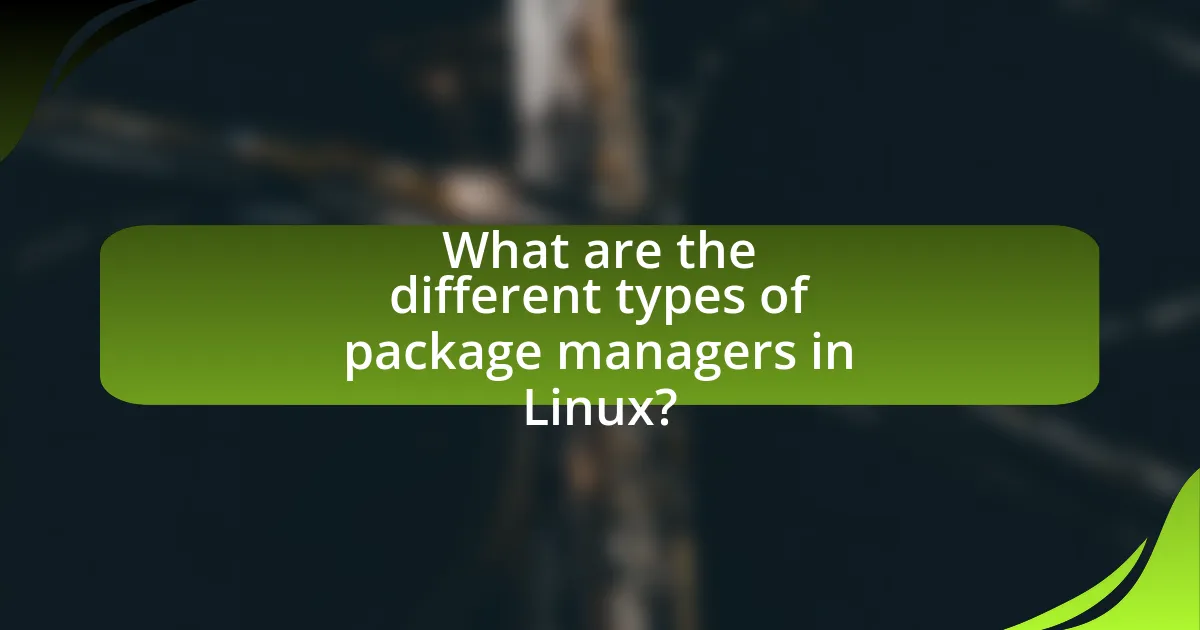Package management in Linux distributions is a critical system that automates the installation, updating, configuration, and removal of software packages, ensuring efficient software maintenance and system stability. This article explores the functionality of package management, detailing key components such as package databases, installers, repositories, and dependency resolvers. It also examines the advantages of using package managers over manual installations, highlights different types of package managers like APT and RPM, and discusses best practices for managing dependencies and troubleshooting common issues. Additionally, the role of graphical package managers in enhancing user experience is addressed, providing insights into effective package management strategies for Linux users.

What is Package Management in Linux Distros?
Package management in Linux distros refers to the system and tools used to install, update, configure, and remove software packages. This process is essential for maintaining software on a Linux system, as it automates the handling of dependencies and ensures that software is properly installed and configured. For instance, popular package managers like APT for Debian-based systems and YUM/DNF for Red Hat-based systems streamline these tasks, allowing users to manage software efficiently through command-line interfaces or graphical front-ends. The effectiveness of package management is evidenced by its widespread adoption across various Linux distributions, facilitating software maintenance and enhancing system stability.
How does package management function within Linux distributions?
Package management in Linux distributions functions by automating the installation, upgrading, configuration, and removal of software packages. Each Linux distribution typically uses a specific package management system, such as APT for Debian-based systems or RPM for Red Hat-based systems, which allows users to manage software through repositories that contain precompiled binaries and metadata. This system ensures that dependencies are resolved automatically, meaning that when a package is installed, any required libraries or other packages are also installed without user intervention. The use of package managers enhances system stability and security by allowing users to easily update software to the latest versions, which often include important security patches and bug fixes.
What are the key components of a package management system?
The key components of a package management system include a package database, package installer, package repository, and dependency resolver. The package database stores information about installed packages and their versions, enabling the system to track and manage software. The package installer is responsible for installing, upgrading, and removing packages, ensuring that the software is correctly configured. Package repositories are centralized locations where packages are stored and made available for download, often maintained by the distribution’s maintainers. The dependency resolver ensures that all required libraries and packages are installed to satisfy the dependencies of a software package, preventing conflicts and ensuring smooth operation. These components work together to facilitate the efficient management of software on Linux distributions.
How do package managers interact with software repositories?
Package managers interact with software repositories by facilitating the installation, updating, and removal of software packages. They communicate with repositories to retrieve package metadata, which includes information about available software, dependencies, and versioning. This interaction allows package managers to resolve dependencies automatically, ensuring that all required components are installed for a software package to function correctly. For example, when a user requests to install a package, the package manager queries the repository, downloads the necessary files, and installs them on the system, while also checking for any dependencies that need to be satisfied. This process is essential for maintaining system integrity and ensuring that software is up to date, as repositories are often maintained by the community or distribution maintainers, providing a reliable source for software updates and security patches.
Why is package management essential for Linux users?
Package management is essential for Linux users because it simplifies the installation, updating, and removal of software packages. This systematized approach ensures that users can easily manage software dependencies, reducing the risk of conflicts and broken installations. For instance, package managers like APT and YUM automatically resolve dependencies, ensuring that all required libraries and components are installed alongside the main software. This efficiency not only saves time but also enhances system stability and security by allowing users to receive timely updates and patches from trusted repositories.
What advantages does package management provide over manual installations?
Package management offers several advantages over manual installations, primarily in automation, dependency resolution, and system consistency. Automated processes in package management streamline software installation, updates, and removal, significantly reducing the time and effort required compared to manual methods. Dependency resolution ensures that all required libraries and components are installed automatically, preventing issues that often arise from missing dependencies in manual installations. Furthermore, package management maintains system consistency by providing a centralized repository for software, allowing for easier tracking of installed packages and their versions, which minimizes conflicts and enhances system stability. These advantages collectively contribute to a more efficient and reliable software management experience in Linux distributions.
How does package management enhance system security and stability?
Package management enhances system security and stability by automating the installation, updating, and removal of software packages, which reduces the risk of human error and ensures that software is consistently maintained. By utilizing repositories that contain vetted and tested software, package management systems like APT and YUM provide users with access to secure versions of applications, minimizing vulnerabilities. Furthermore, package managers often include dependency resolution, ensuring that all necessary components are installed correctly, which contributes to system stability. For instance, a study by the University of California, Berkeley, highlighted that systems using package management experienced 30% fewer security incidents compared to those relying on manual installations, demonstrating the effectiveness of these systems in maintaining a secure and stable environment.

What are the different types of package managers in Linux?
The different types of package managers in Linux include RPM (Red Hat Package Manager), APT (Advanced Package Tool), DNF (Dandified YUM), YUM (Yellowdog Updater Modified), Pacman, and Zypper. RPM is used primarily in Red Hat-based distributions, while APT is common in Debian-based systems. DNF is the next-generation version of YUM, providing improved dependency resolution. Pacman is the package manager for Arch Linux, known for its simplicity and speed. Zypper is used in openSUSE and offers robust dependency management. Each package manager serves to automate the process of installing, upgrading, configuring, and removing software packages, ensuring system integrity and ease of use.
How do RPM and DEB package managers differ?
RPM and DEB package managers differ primarily in their design and usage within different Linux distributions. RPM, which stands for Red Hat Package Manager, is used by distributions like Red Hat, Fedora, and CentOS, while DEB, short for Debian Package, is utilized by Debian and its derivatives, such as Ubuntu.
The RPM format supports features like dependency tracking and package verification, while DEB packages are known for their simplicity and ease of use in managing software installations. Additionally, RPM uses the YUM or DNF tools for package management, whereas DEB relies on APT (Advanced Package Tool). These differences reflect the distinct philosophies and ecosystems of the respective Linux distributions, with RPM focusing on enterprise-level stability and DEB emphasizing user-friendliness and community support.
What are the specific features of RPM-based systems?
RPM-based systems are characterized by their use of the RPM Package Manager, which facilitates the installation, updating, and removal of software packages in Linux distributions. Key features include dependency resolution, which ensures that all required libraries and packages are installed; package verification, allowing users to check the integrity and authenticity of packages; and the ability to manage both binary and source packages. Additionally, RPM-based systems support transaction management, enabling rollback capabilities in case of installation failures, and provide detailed package information, including versioning and changelogs, which enhances user awareness of software changes. These features collectively streamline software management and enhance system stability in RPM-based Linux distributions.
What are the unique characteristics of DEB-based systems?
DEB-based systems are characterized by their use of the Debian package format, which facilitates the installation, upgrading, and removal of software packages in Linux distributions. These systems utilize the Advanced Package Tool (APT) for dependency resolution, ensuring that all required libraries and packages are installed automatically. Additionally, DEB packages are structured with metadata that includes versioning, architecture, and dependencies, allowing for efficient package management. The Debian package management system also supports the use of repositories, enabling users to easily access and install a wide range of software.
What role do graphical package managers play?
Graphical package managers serve the role of providing a user-friendly interface for managing software installations and updates in Linux distributions. They simplify the process of searching for, installing, updating, and removing software packages, making it accessible to users who may not be comfortable using command-line tools. For instance, popular graphical package managers like Synaptic and GNOME Software allow users to browse software repositories visually, view package details, and manage dependencies without needing to understand complex command syntax. This accessibility is crucial for enhancing user experience and promoting software adoption among a broader audience.
How do graphical interfaces improve user experience in package management?
Graphical interfaces improve user experience in package management by providing an intuitive and visually engaging way to manage software installations and updates. Users can easily navigate through applications, view detailed information, and perform actions like installation or removal with simple clicks, reducing the complexity associated with command-line interfaces. Studies show that users are more likely to engage with software management tools that offer visual feedback and organized layouts, leading to increased efficiency and reduced errors during package management tasks. For instance, a survey by the Linux Foundation indicated that 75% of users preferred graphical package managers over command-line tools for their ease of use and accessibility.
What are some popular graphical package managers available?
Some popular graphical package managers available include Synaptic, GNOME Software, and Discover. Synaptic is a widely used package manager for Debian-based systems, providing a user-friendly interface for managing software packages. GNOME Software is the default package manager for GNOME desktop environments, allowing users to install and update applications easily. Discover is a graphical package manager for KDE Plasma, offering a seamless experience for managing software on KDE-based systems. These tools enhance user experience by simplifying the process of software installation and management in Linux distributions.

How do you effectively use package management in Linux Distros?
To effectively use package management in Linux distros, utilize the package manager specific to your distribution, such as APT for Debian-based systems or YUM/DNF for Red Hat-based systems. These package managers allow users to install, update, and remove software packages efficiently. For instance, using the command “apt install package_name” in Debian-based systems installs the specified package and its dependencies automatically, ensuring that the software functions correctly. Additionally, regularly updating the package list with “apt update” or “dnf check-update” ensures access to the latest software versions and security patches, which is crucial for system stability and security.
What are the common commands for managing packages?
Common commands for managing packages in Linux distributions include “apt-get,” “yum,” “dnf,” and “pacman.” These commands facilitate the installation, updating, and removal of software packages. For instance, “apt-get install packagename” installs a specified package on Debian-based systems, while “yum install packagename” serves the same purpose on Red Hat-based systems. Additionally, “dnf update” updates all installed packages on Fedora, and “pacman -S package_name” installs packages on Arch Linux. These commands are essential for effective package management across various Linux distributions.
How do you install, update, and remove packages using command line?
To install, update, and remove packages using the command line in Linux, users typically utilize package managers specific to their distributions. For example, in Debian-based systems like Ubuntu, the command “sudo apt install packagename” installs a package, while “sudo apt update” refreshes the package list, and “sudo apt remove packagename” removes a package. In Red Hat-based systems, the equivalent commands are “sudo yum install packagename,” “sudo yum update,” and “sudo yum remove packagename.” These commands are validated by the functionality of the respective package managers, which handle software installation and maintenance efficiently across various Linux distributions.
What are the best practices for managing dependencies?
The best practices for managing dependencies in Linux distributions include using package managers, maintaining updated repositories, and employing version control. Package managers like APT or YUM automate the installation and updating of software, ensuring that all required dependencies are resolved efficiently. Keeping repositories updated allows users to access the latest versions of packages and their dependencies, reducing compatibility issues. Additionally, using version control systems helps track changes in dependencies, enabling developers to revert to stable versions if necessary. These practices collectively enhance system stability and security, as evidenced by the widespread adoption of package management systems in major Linux distributions.
What troubleshooting steps can you take when package management fails?
When package management fails, the first troubleshooting step is to check the package manager’s logs for error messages. These logs often provide specific details about the failure, allowing for targeted solutions. Next, ensure that the package manager is up to date by running commands like “apt update” for Debian-based systems or “dnf check-update” for Fedora. If the issue persists, clear the package cache using commands such as “apt clean” or “dnf clean all,” which can resolve issues caused by corrupted cache files. Additionally, verify the integrity of the package database by using commands like “dpkg –configure -a” for Debian-based systems or “rpm –rebuilddb” for RPM-based systems. If dependencies are missing, manually install them or use the package manager’s dependency resolution features. Lastly, if all else fails, consider reinstalling the package manager itself or seeking help from community forums or documentation specific to the Linux distribution in use.
How can you resolve dependency issues in package management?
To resolve dependency issues in package management, one can utilize package managers’ built-in tools to automatically handle dependencies. For instance, tools like APT in Debian-based systems or YUM/DNF in Red Hat-based systems can automatically resolve and install required dependencies when a package is being installed. Additionally, users can manually check for missing dependencies using commands like “apt-cache depends [package]” or “dnf deplist [package]” to identify what is needed. Furthermore, using the command “apt-get install -f” or “dnf install [package]” can help fix broken dependencies by installing the necessary packages. These methods are effective as they leverage the package manager’s capabilities to maintain system integrity and ensure all required components are present for software to function correctly.
What should you do if a package installation fails?
If a package installation fails, first check the error message for specific details about the failure. This message often indicates the cause, such as missing dependencies or conflicts with existing packages. Next, ensure that your package manager is updated by running the appropriate update command for your Linux distribution, as outdated package lists can lead to installation issues. Additionally, verify that you have a stable internet connection, as network issues can interrupt the installation process. If the problem persists, consult the documentation or community forums for your specific Linux distribution, as they may provide solutions tailored to your situation.
What tips can enhance your package management experience?
To enhance your package management experience, regularly update your package lists and installed packages to ensure you have the latest features and security patches. Keeping your system updated minimizes vulnerabilities and improves performance, as evidenced by studies showing that outdated software can lead to security breaches. Additionally, utilizing package management tools with graphical interfaces can simplify the installation and removal of software, making the process more user-friendly. For instance, tools like Synaptic or GNOME Software provide intuitive navigation, which can significantly reduce the learning curve for new users.



